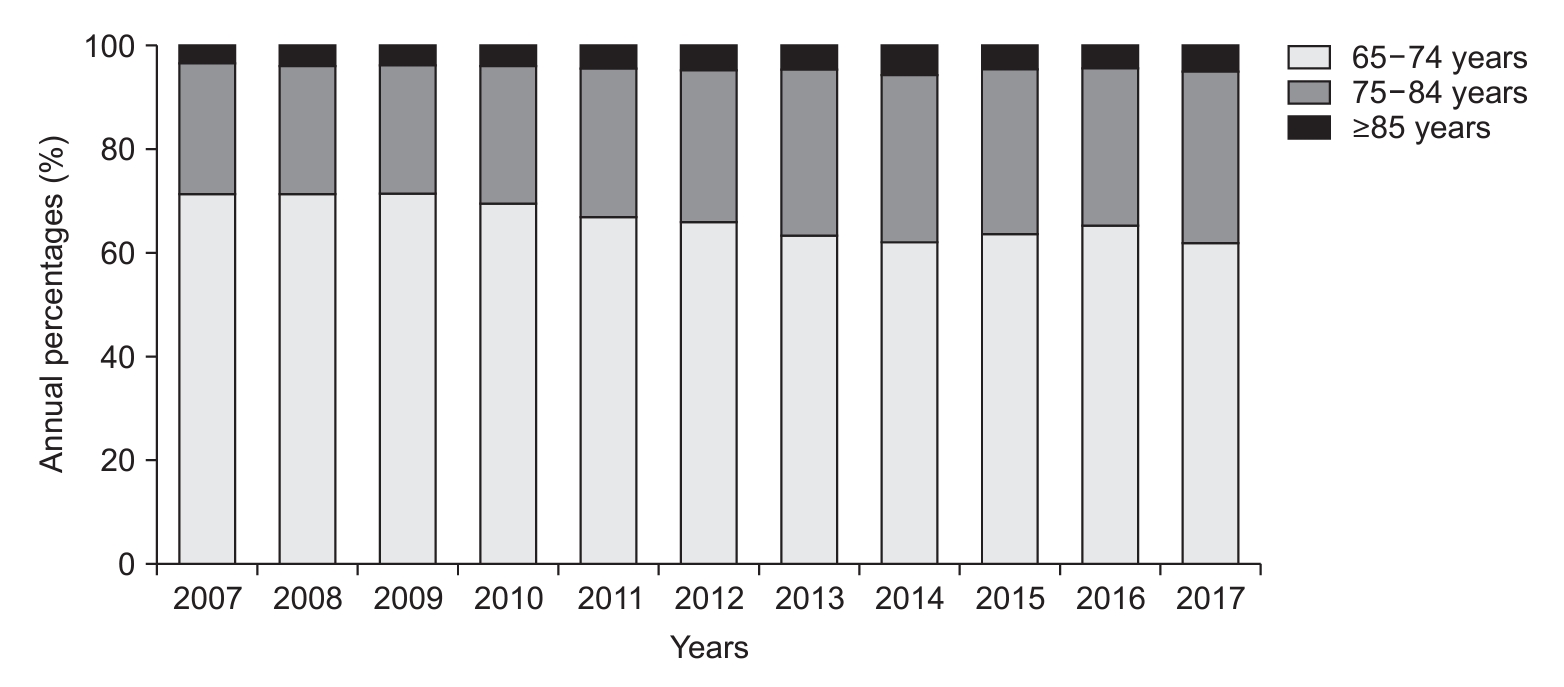 |
 |
| Tuberc Respir Dis > Epub ahead of print |
|
Abstract
Background
Methods
Results
Notes
Authors’ Contributions
Conceptualization: Lee SI, Lim CM. Methodology: Lee SI, Lim CM. Formal analysis: all authors. Data curation: all authors. Validation: Lee SI, Lim CM. Investigation: Lee SI, Lim CM. Writing - original draft preparation: Lee SI, Lim CM. Writing - review and editing: all authors. Approval of final manuscript: all authors.
Acknowledgments
Supplementary Material
Supplementary Table S1.
Supplementary Table S2.
Supplementary Table S3.
Supplementary Table S4.
Supplementary Table S5.
Table 1.
Table 2.
Table 3.
| Variable |
Univariate analysis |
Multivariate analysis |
||||
|---|---|---|---|---|---|---|
| OR | 95% CI | p-value | OR | 95% CI | p-value | |
| Age, yr | ||||||
| 65-74 (O group) | Reference | |||||
| 75-84 (VO group) | 1.450 | 1.332-1.579 | <0.001 | 1.267 | 1.151-1.395 | <0.001 |
| ≥85 (VVO group) | 2.499 | 2.147-2.908 | <0.001 | 2.031 | 1.701-2.425 | <0.001 |
| Male sex | 1.239 | 1.142-1.344 | <0.001 | 1.200 | 1.096-1.314 | <0.001 |
| Medical ICU admission | 3.885 | 3.563-4.237 | <0.001 | 3.479 | 3.129-3.868 | <0.001 |
| Admission source | ||||||
| Ward | Reference | |||||
| ER | 3.964 | 3.623-4.336 | <0.001 | 2.112 | 1.895-2.353 | <0.001 |
| Others* | 2.390 | 1.703-3.354 | <0.001 | 2.274 | 1.566-3.303 | <0.001 |
| Underlying disease | ||||||
| Chronic heart disease | 1.084 | 0.977-1.202 | 0.130 | |||
| Hematologic malignancy | 2.712 | 1.768-4.160 | <0.001 | 1.580 | 0.956-2.612 | 0.075 |
| Solid tumor | 1.392 | 1.168-1.659 | <0.001 | 1.109 | 0.906-1.358 | 0.316 |
| Chronic liver disease | 1.610 | 1.261-2.055 | <0.001 | 1.515 | 1.142-2.011 | 0.004 |
| Chronic lung disease | 1.318 | 1.122-1.549 | 0.001 | 1.027 | 0.853-1.236 | 0.780 |
| DM | 1.199 | 1.102-1.305 | <0.001 | 1.016 | 0.923-1.118 | 0.742 |
| CKD | 2.086 | 1.706-2.549 | <0.001 | 1.338 | 1.063-1.684 | 0.013 |
| CKD on HD† | 2.445 | 1.772-3.373 | <0.001 | |||
| CVA | 1.015 | 0.879-1.171 | 0.842 | |||
| Transplantation | 1.589 | 0.862-2.928 | 0.138 | |||
| Support during index ICU stay | ||||||
| Invasive mechanical ventilation | 10.080 | 9.106-11.158 | <0.001 | 5.862 | 5.194-6.616 | <0.001 |
| Vasopressors | 5.117 | 4.701-5.570 | <0.001 | 2.922 | 2.623-3.255 | <0.001 |
| ICU readmission | 2.594 | 2.335-2.883 | <0.001 | 1.734 | 1.533-1.962 | <0.001 |
References
- TOOLS
-
METRICS

-
- 0 Crossref
- Scopus
- 260 View
- 13 Download
- ORCID iDs
-
Song I Lee

https://orcid.org/0000-0001-8372-4511Chae-Man Lim

https://orcid.org/0000-0001-5400-6588 - Related articles




 PDF Links
PDF Links PubReader
PubReader ePub Link
ePub Link Data Sharing Statement
Data Sharing Statement Full text via DOI
Full text via DOI Supplement1
Supplement1 Print
Print Download Citation
Download Citation



